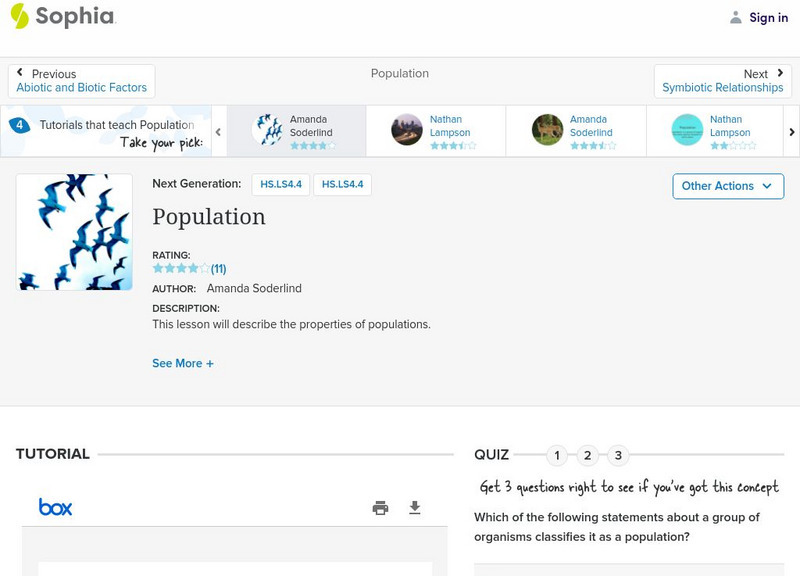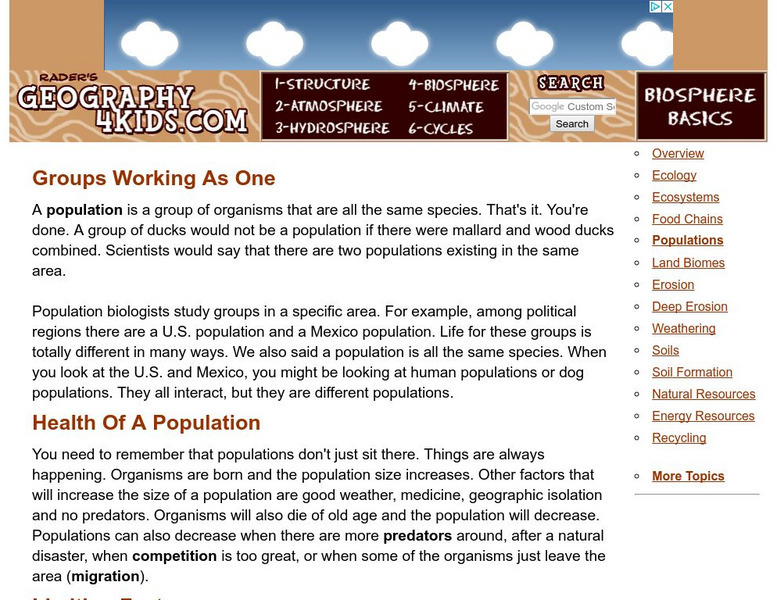TED Talks
Ted: Ted Ed: Why Is Biodiversity So Important?
Our planet's diverse, thriving ecosystems may seem like permanent fixtures, but they're actually vulnerable to collapse. Jungles can become deserts, and reefs can become lifeless rocks. What makes one ecosystem strong and another weak in...
PBS
Pbs Nature: Gray Wolf
Gray wolves were a frequent sight on the American plains, however, they are now an endangered species despite attempts to reintroduce them to their former habitats in the continental United States. Learn about their natural history in...
Howard Hughes Medical Institute
Hhmi: Biointeractive: The Making of Mass Extinctions
This interactive module explores the environmental factors and species involved in five major mass extinctions.
CK-12 Foundation
Ck 12: Life Science: 12.3 Population
Discover what a population is in regards to an ecosystem.
CK-12 Foundation
Ck 12: Life Science: 12.2 Ecological Organization
See how ecosystems are organized into several different levels, and an ecosystem can be studied at any one of the various levels of organization.
CK-12 Foundation
Ck 12: Life Science: 10.25 Primates and Humans
Understand the genetic similarities between humans and primates.
CK-12 Foundation
Ck 12: Life Science: 4.7 Microevolution and Macroevolution
Understand the difference between microevolution and macroevolution.
CK-12 Foundation
Ck 12: Life Science: 11.9 Organization of Living Things
Learn the system that scientists use to classify living things.
CK-12 Foundation
Ck 12: Earth Science: Biological Communities Study Guide
Review the relationship between populations and ecosystems.
American Museum of Natural History
American Museum of Natural History: What Is a "Species"?
Explanation of different scientific approaches to defining the concept of species, using the red crossbill (a seed-eating finch) as an example. Learn what is meant by the biological species concept and the phylogenetic species concept.
Cosmo Learning
Cosmo Learning: Principles of Evolution, Ecology and Behavior
A collection of video lectures introducing beginning biology students to the principles of evolution, ecology, and behavior. The course was taught three times a week for a semester at Yale University. The course discusses concepts of...
PBS
Pbs Learning Media: Now You See It
Students are asked to identify ways to help these endangered or threatened species.
University of California
Cog Web: Can Matter Store Active Information?
This site provides a timeline of historical events in regards to discovery and research on genetics.
Talk Origins Archive
Talk origins.org: The Basics of Sexual Selection
This content from TalkOrigins.org is within a discussion of frequently asked questions about evolution. It discusses some basics about sexual selection. It also provides an explanation for the usual dominanceof the female in the sexual...
Wikimedia
Wikipedia: Binomial Nomenclature
Wikipedia, an open-source encyclopedia, offers great information on the classification system used in Biology. Covers the benefits of the system, history, and general information on the whole system together.
PBS
Pbs Teachers: Scientific American: Wild Places: Identifying Species
Sort and classify insects and spiders by characteristics, using stamps from the United States postal stamp Classic Collection. Create a taxonomic key to distinguish between any four animals.
Sophia Learning
Sophia: Population: Lesson 2
This lesson will describe the properties of populations. It is 2 of 8 in the series titled "Population."
Sophia Learning
Sophia: Population: Lesson 3
This lesson will describe the properties of populations. It is 3 of 8 in the series titled "Population."
Sophia Learning
Sophia: Population: Lesson 4
This lesson will describe the properties of populations. It is 4 of 8 in the series titled "Population."
Sophia Learning
Sophia: Three Domains/ Five Kingdoms /Taxonomy: Lesson 3
This lesson presents the organizational categories of living things. It is 3 of 3 in the series titled "Three Domains/ Five Kingdoms /Taxonomy."
Geography 4 kids
Geography4 kids.com: Groups Working as One: Population
Some biologists study the population of organisms belonging to the same species. Discover the factors that limit populations and what affects the health of a population.
Sophia Learning
Sophia: Classification of Organisms: Lesson 1
This lesson will introduce taxonomy and give an example by providing the scientific classification of an organism. It is 1 of 2 in the series titled "Classification of Organisms."
Sophia Learning
Sophia: Three Domains/ Five Kingdoms /Taxonomy: Lesson 2
This lesson presents the organizational categories of living things. It is 2 of 3 in the series titled "Three Domains/ Five Kingdoms /Taxonomy."


















